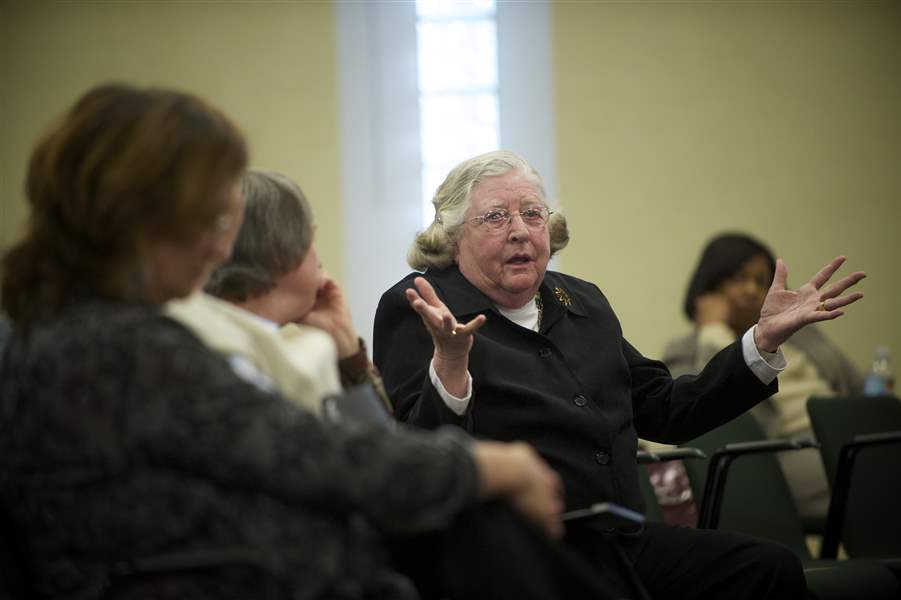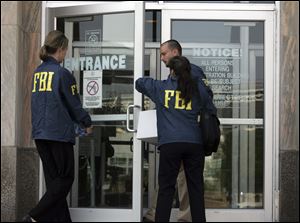
Frustrations trigger government overhaul; Executive, 11-member council to take reins
4/25/2010
Kathleen Stoll, 74, of Cuyahoga County's Beachwood maintains the county needed to reorganize its whole structure, not just change elected officials.
Jason Miller
CLEVELAND — Even before the biggest political scandal ever to hit Cuyahoga County government struck in July, 2008, whispers of reform percolated in northeast Ohio.
Clevelanders and their suburban neighbors — similar to Toledoans and residents of other Great Lakes cities mired in unemployment and economic stagnation — were tired of witnessing business as usual among elected leadership while the poor grew poorer and the middle class lost ground.
Jobs were vanishing. Tax revenues, population figures, and hope were in a perpetual slump. Sound familiar?
“People in Cleveland were generally dissatisfied for a while,” said Steve Millard, president and executive director of the region's chief small business support organization headquartered in downtown Cleveland.
Voters in Cuyahoga County expressed just how frustrated they were last year when they approved an entire overhaul of their county government.
Come January, the urban county of about 1.3 million people with a $1.4 billion budget no longer will have county commissioners. Nor will they have an elected auditor, treasurer, sheriff, coroner, clerk of courts, recorder, or engineer.
On Nov. 3, the electorate overwhelmingly approved Issue 6 — which provided for a charter form of government consisting of an elected county executive (think “county mayor”) and 11 elected county councilmen. Voters will continue to elect the county prosecutor, and qualified professionals are to be appointed by the county executive to fulfill the duties of the eliminated elected offices.
Of Ohio's 88 counties, the only other with that form of government is Summit County — to the south of Cuyahoga with Akron as its county seat — which adopted its charter in 1979.
No matter the impetus for a complete government overhaul — ridding the county of corruption, breaking from an outdated, inefficient government style, or improving the local economy — county residents made it clear that voting out incumbents when they were up for re-election was not enough.
“We needed to reorganize the whole system,” said Kathleen Stoll, 74, a Cuyahoga County resident who lives in Beechwood. “Changing people wasn't going to do the job. We had to change the structure.”
A corrupt culture
On July 28, 2008, the FBI raided Cuyahoga County government headquarters in downtown Cleveland and the homes of Commissioner Jimmy Dimora and Auditor Frank Russo. The feds were investigating a culture of bribery and cash kickbacks in exchange for business contracts and political favors.

On July 28, 2008 , FBI agents enter a city-county building in downtown Cleveland during an investigation of public corruption. The same day, agents raided the homes of Cuyahoga County Commissioner Jimmy Dimora, at far left, and county Auditor Frank Russo, near left. Neither has been charged and both deny wrongdoing, but voters nevertheless opted to change their government.
Mr. Dimora, former chairman of the Cuyahoga County Democratic Party and a commissioner since 1998, and Mr. Russo, a Democrat who's held an elected countywide office since 1985, haven't been charged and have denied wrongdoing, according to published reports. But about 20 former county employees and businessmen have pleaded guilty for their roles in the bribery scandal.
The suburban politicians, businessmen, and average citizens who pushed for reform all say the obvious pay-to-play culture prevalent in at least some Cuyahoga County offices aided the reform effort, but they insist there were other factors in play.
And there was certainly no shortage of appetite for reform in the county.
While a bipartisan coalition of suburban Democratic and Republican mayors, the Democratic county prosecutor, and the business community were pushing for a charter government, Mr. Dimora's counterparts on the board of commissioners placed a competing reform issue on the ballot.
Called Issue 5, Democratic commissioners Tim Hagan and Peter Lawson Jones' ballot initiative would've established a 15-person panel to review possible reforms and recommend their favorites for a vote this year.
The competing ballot issues were on top of decades of failed reform efforts, including one supported by Ohio Gov. Ted Strickland that died in the state legislature in 2008.

“There was never a disagreement that reform needed to happen,” said Cuyahoga County Administrator James McCafferty, the top nonelected official in county government.
Achieving change
With $1 million raised by the business community, the endorsement of the (Cleveland) Plain Dealer, and the collaboration of Democrats, Republicans, and independents, Issue 6 passed countywide with 66 percent of the vote.
After campaign organizers collected more than 46,000 valid signatures to place Issue 6 on the ballot, the referendum passed in every Cuyahoga County community, with margins of about 10,000 votes in Cleveland and 100,000 votes in the suburbs.
The commissioners' Issue 5 to create yet-another committee lost in a landslide.
“The people of Cuyahoga County took their government back,” said Martin Zanotti, a Democrat who is credited as a primary architect of Issue 6 and was at the time the mayor of Parma Heights, a Cleveland suburb. “People decided county government didn't have the right purpose. They decided they didn't like how government was being run.”
Economic focus
The opening line of Cuyahoga County's newly adopted charter says it all.
“We, the people of Cuyahoga County, Ohio, desire a reformed County Government to significantly improve the County's economic competitiveness,” the charter begins.
Mr. Zanotti said that rather than harp on the alleged corruption in county government, Issue 6 organizers focused on the county's economic woes.
Unemployment in August and September, 2009, ranged between 9.6 and 8.9 percent. By comparison, the unemployment rate in Lucas County at that time exceeded 11 percent.
Bruce Akers, the Republican mayor of Pepper Pike who partnered with Mr. Zanotti to lead Cuyahoga County reform, said he wanted the charter to set the course for a more diligent development effort.
“We're losing jobs, people, and companies, and there's no viable, long-range economic development plan coming out of the county,” Mr. Akers said. “In terms of the economy and economic development, we have no direction to go but up.”
The charter, at the urging of Mr. Akers, mandates the existence of an economic development commission, a development director, and a yearly presentation of a five-year economic development plan that must be adopted by council.
Mr. Hagan, a former Democratic gubernatorial candidate whose 22 years as a commissioner are about to end, said he doesn't see how these changes will translate into economic growth.
Cuyahoga County currently has a development director and has budgeted $57.7 million for development in 2010. And about $950 million from the county budget is locked into funding social services and the justice system, leaving the incoming executive and council little wiggle room.
“To claim a charter government is going to create better economic development in Cuyahoga County is fallacious on the face of it,” Mr. Hagan said. “The people who say these things don't understand the county's revenue stream.”
‘A blessing'
That's not to say that Mr. Hagan is against all county government reform.
He once supported doing away with some of the “row offices” of county government, such as the treasurer, auditor, and recorder, and leaving the commissioners in place.
Also, some of the top nonelected officials currently in county government were very much in favor of government reform in some capacity and appreciate some of what will be accomplished by the charter.
“There are some really good, excellent things to come out of this,” said Mr. McCafferty, the Cuyahoga County administrator who was one of three government employees appointed by the commissioners to spearhead the transition to a charter government.
Come January, the county will only have one elected leader as its chief decision and deal maker. An elected treasurer, sheriff, engineer, and auditor won't all be submitting budgets for approval, erasing many budgetary headaches in times of fiscal strife. There are also wasteful redundancies such as information technology staff and systems in elected officials' departments that will be streamlined.
“This is a blessing, period. Not just a blessing in disguise,” said Gary Holland, the director of the county's justice affairs department and another charter transition leader. “It allows for an attempt at better governance, and we should all want that.”
A question of savings
Some involved with the transition question whether some of the cost savings and efficiencies intended by the charter's creators will ever materialize.
The county executive, who will serve a four-year term, will be paid a base salary of $175,000 plus benefits. Ten of the county councilmen will be paid $45,000 (the council president will make $55,000), but a debate is ongoing as to whether council positions should be full-time.
If it is determined county council is a full-time job, benefits and added staff will drive up costs.
The charter also establishes duties for — and relationships between — the county executive and council very similar to those of municipal mayors and councils. One need look no further than Toledo to see the gridlock that can develop over budgets in the strong mayor-council form of government.
Also, the county charter does not supersede the home rule of the county's established municipalities, so any steps toward regionalism still will need the cooperation of the county's many fiefdoms.
“People were just so frustrated that they thought something different had to be better,” said John Nolan, a government relations employee at the Cleveland Clinic and former Cuyahoga County staffer. Mr. Nolan volunteered to aid with the charter transition.
“What we got was definitely different. I just don't know if it's better.”
Public support
Despite its unanswered questions, Cuyahoga County's residents continue to rally behind the charter. More than 1,000 people volunteered for work groups to make recommendations for the incoming executive and council, and more than 100 meetings have been held.
More than 30 people attended a health and human services committee meeting in Cleveland on Wednesday night. Organizers say it was easily the committee's smallest attendance.
“The lesson here is that people can't just fall asleep and let the government run itself however it wants,” Mr. Zanotti said. “We have to remember that we should be watchdogs of government and make sure we're being represented.”
And for at least one in attendance at that Wednesday night meeting, Cleveland Heights resident Mario Tonti, a different government means a better government.
And if not, the charter grants residents the power to recall any of its elected county leaders — a tool voters in Lucas County don't have.
“We're taking all of what county government does and shaking it up,” he said. “What comes out will be better.”
Contact Joe Vardon at:jvardon@theblade.comor 419-724-6559.